11. Dialogs in Tkinter
By Bernd Klein. Last modified: 01 Feb 2022.
Introduction
Tkinter (and TK of course) provides a set of dialogues (dialogs in American English spelling), which can be used to display message boxes, showing warning or errors, or widgets to select files and colours. There are also simple dialogues, asking the user to enter string, integers or float numbers.
Let's look at a typical GUI Session with Dialogues and Message boxes. There might be a button starting the dialogue, like the "quit" button in the following window:

Pushing the "quit" button raises the Verify window:

Let's assume that we want to warn users that the "quit" functionality is not yet implemented. In this case we can use the warning message to inform the user, if he or she pushes the "yes" button:
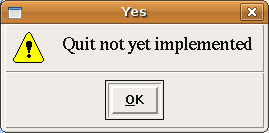
If somebody types the "No" button, the "Cancel" message box is raised:
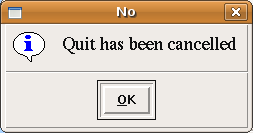
Let's go back to our first Dialogue with the "quit" and "answer" buttons. If the "Answer" functionality is not implemented, it might be useful to use the following error message box:
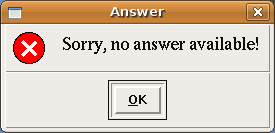
Python script, which implements the previous dialogue widges:
import tkinter as tk
from tkinter import messagebox as mb
def answer():
mb.showerror("Answer", "Sorry, no answer available")
def callback():
if mb.askyesno('Verify', 'Really quit?'):
mb.showwarning('Yes', 'Not yet implemented')
else:
mb.showinfo('No', 'Quit has been cancelled')
tk.Button(text='Quit', command=callback).pack(fill=tk.X)
tk.Button(text='Answer', command=answer).pack(fill=tk.X)
tk.mainloop()
Live Python training
Message Boxes
The message dialogues are provided by the 'messagebox' submodule of tkinter.
'messagebox' consists of the following functions, which correspond to dialog windows:
- askokcancel(title=None, message=None, **options)
Ask if operation should proceed; return true if the answer is ok - askquestion(title=None, message=None, **options)
Ask a question - askretrycancel(title=None, message=None, **options)
Ask if operation should be retried; return true if the answer is yes - askyesno(title=None, message=None, **options)
Ask a question; return true if the answer is yes - askyesnocancel(title=None, message=None, **options)
Ask a question; return true if the answer is yes, None if cancelled. - showerror(title=None, message=None, **options)
Show an error message - showinfo(title=None, message=None, **options)
Show an info message - showwarning(title=None, message=None, **options)
Show a warning message
Open File Dialogue
There is hardly any serious application, which doesn't need a way to read from a file or write to a file. Furthermore, such an application might have to choose a directory. Tkinter provides the module tkFileDialog for these purposes.
import tkinter as tk
from tkinter import filedialog as fd
def callback():
name= fd.askopenfilename()
print(name)
errmsg = 'Error!'
tk.Button(text='File Open',
command=callback).pack(fill=tk.X)
tk.mainloop()
The code above creates a window with a single button with the text "File Open". If the button is pushed, the following window appears:

The look-and-feel of the file-open-dialog depends on the GUI of the operating system. The above example was created using a gnome desktop under Linux. If we start the same program under Windows 7, it looks like this:
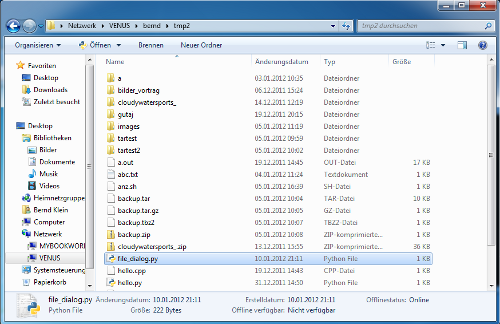
Live Python training
Upcoming online Courses
10 Mar 2025 to 14 Mar 2025
07 Apr 2025 to 11 Apr 2025
23 Jun 2025 to 27 Jun 2025
28 Jul 2025 to 01 Aug 2025
Efficient Data Analysis with Pandas
10 Mar 2025 to 11 Mar 2025
07 Apr 2025 to 08 Apr 2025
02 Jun 2025 to 03 Jun 2025
23 Jun 2025 to 24 Jun 2025
28 Jul 2025 to 29 Jul 2025
09 Apr 2025 to 11 Apr 2025
04 Jun 2025 to 06 Jun 2025
Python and Machine Learning Course
10 Mar 2025 to 14 Mar 2025
07 Apr 2025 to 11 Apr 2025
02 Jun 2025 to 06 Jun 2025
28 Jul 2025 to 01 Aug 2025
Deep Learning for Computer Vision (5 days)
10 Mar 2025 to 14 Mar 2025
07 Apr 2025 to 11 Apr 2025
02 Jun 2025 to 06 Jun 2025
28 Jul 2025 to 01 Aug 2025
Choosing a Colour
There are applications where the user should have the possibility to select a colour. Tkinter provides a pop-up menu to choose a colour. To this purpose we have to import the 'tkinter.colorchooser' module and have to use the method askColor:
result = tkinter.colorchooser.askcolor ( color, option=value, ...)
If the user clicks the OK button on the pop-up window, respectively, the return value of askcolor() is a tuple with two elements, both a representation of the chosen colour, e.g. ((106, 150, 98), '#6a9662')
The first element return[0] is a tuple (R, G, B) with the RGB representation in decimal values (from 0 to 255). The second element return[1] is a hexadecimal representation of the chosen colour.
If the user clicks "Cancel" the method returns the tuple (None, None).
The optional keyword parameters are:
| color | The variable color is used to set the default colour to be displayed. If color is not set, the initial colour will be grey. |
| title | The text assigned to the variable title will appear in the pop-up window's title area. The default title is "Color". |
| parent | Make the pop-up window appear over window W. The default behaviour is that it appears over the root window. |
Let's have a look at an example:
import tkinter as tk
from tkinter.colorchooser import askcolor
def callback():
result = askcolor(color="#6A9662",
title = "Bernd's Colour Chooser")
print(result)
root = tk.Tk()
tk.Button(root,
text='Choose Color',
fg="darkgreen",
command=callback).pack(side=tk.LEFT, padx=10)
tk.Button(text='Quit',
command=root.quit,
fg="red").pack(side=tk.LEFT, padx=10)
tk.mainloop()
The look and feel depends on the operating system (e.g. Linux or Windows) and the chosen GUI (GNOME, KDE and so on). The following windows appear, if you use Gnome:

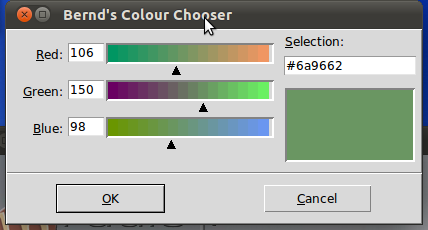
Using the same script under Windows 7 gives us the following result:
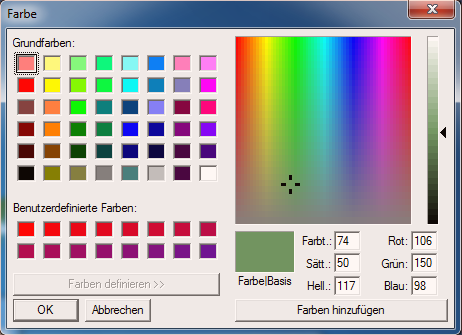
Live Python training
Upcoming online Courses
10 Mar 2025 to 14 Mar 2025
07 Apr 2025 to 11 Apr 2025
23 Jun 2025 to 27 Jun 2025
28 Jul 2025 to 01 Aug 2025
Efficient Data Analysis with Pandas
10 Mar 2025 to 11 Mar 2025
07 Apr 2025 to 08 Apr 2025
02 Jun 2025 to 03 Jun 2025
23 Jun 2025 to 24 Jun 2025
28 Jul 2025 to 29 Jul 2025
09 Apr 2025 to 11 Apr 2025
04 Jun 2025 to 06 Jun 2025
Python and Machine Learning Course
10 Mar 2025 to 14 Mar 2025
07 Apr 2025 to 11 Apr 2025
02 Jun 2025 to 06 Jun 2025
28 Jul 2025 to 01 Aug 2025
Deep Learning for Computer Vision (5 days)
10 Mar 2025 to 14 Mar 2025
07 Apr 2025 to 11 Apr 2025
02 Jun 2025 to 06 Jun 2025
28 Jul 2025 to 01 Aug 2025
